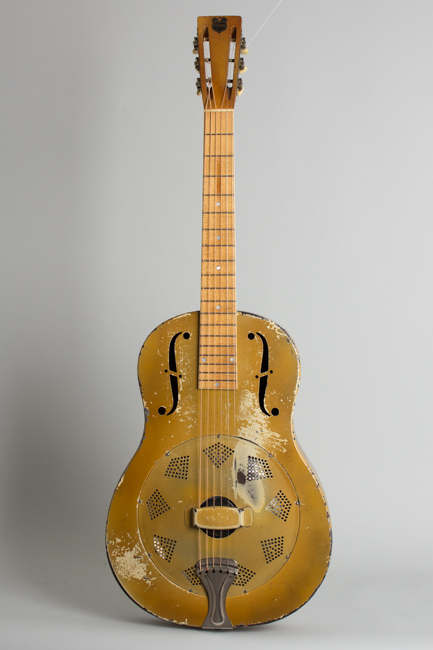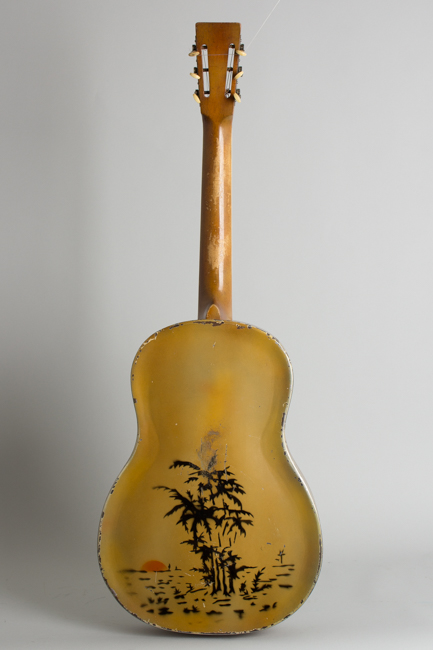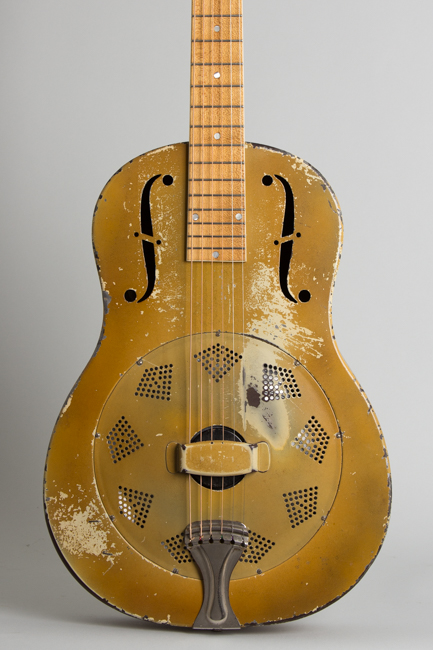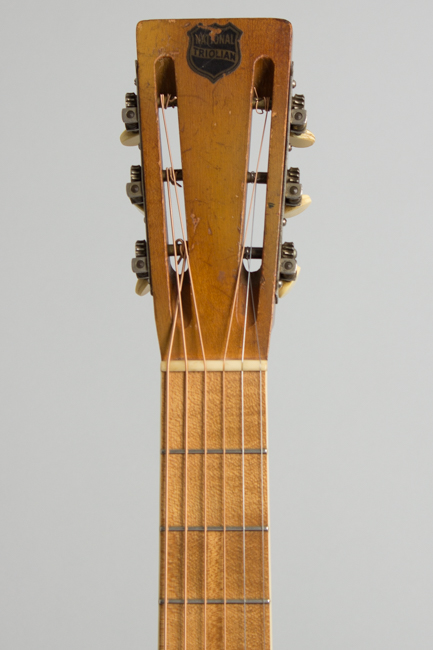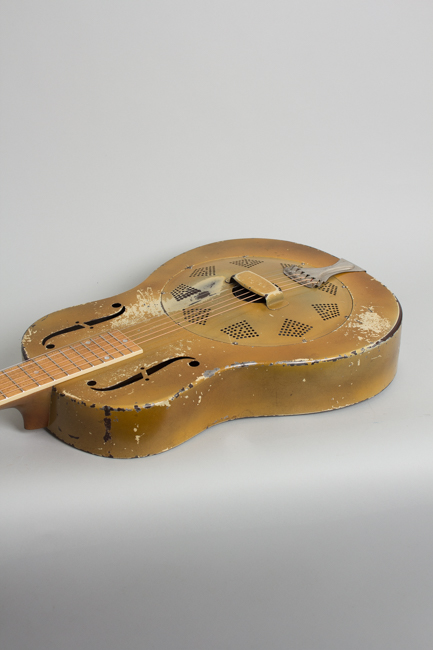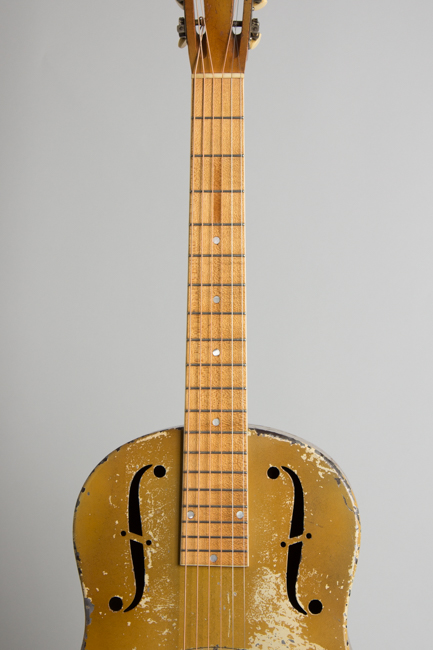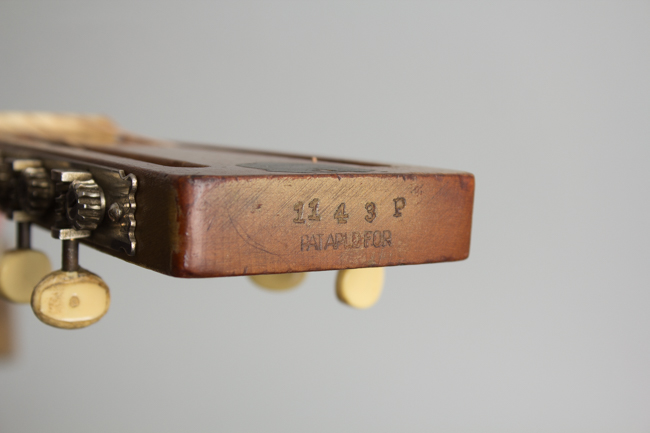National Triolian Resophonic Guitar (1931)
National Triolian Model Resophonic Guitar (1931), made in Los Angeles, California, serial # 1143P, Polychrome enamel with stenciling finish, steel body, basswood neck, black tolex hard shell case.
This is a well-worn but good playing example of an original steel-bodied Triolian, National's "bread and butter" guitar during the Depression. Offering great sound and serious volume at the relatively modest price of $45.00, the Triolian was crucial to the company's survival in the 1930s. With National Tricone guitars priced well over $100 and the flashy brass-bodied Style 0 at $62.50, the single-cone Triolian made the National sound available to a much wider range of players. Made of slightly better grade materials than the bottom-of-the-line $32.50 Duolian, the Triolian was extremely popular among blues and hillbilly musicians and is still an excellent choice for many styles of playing.
This 1931 "Polychrome" example dates to the first couple of production years. It has seen some restoration returning it to good playing condition. The multi-hued enamel-finished steel body with flat-cut f-holes; this one is a more uniform mustard hue than many Triolians with very little of the "Poly" hued assents visible. These were hand-sprayed so no two are exactly alike. The back has a very bold and cleanly stenciled palm tree & sunset motif, the distinctive visual signature of the Polychrome Triolian.
The 12-fret basswood neck has a much thinner profile than some, with a fairly subtle "V" spine. It is fitted with a maple fingerboard; the original dyed wood has been planed and refinished amber natural. This is bound in ivoroid and though not painted as it originally was still harmonizes nicely with the color scheme. The tuner strips on the slotted headstock are the older 1920s cloverleaf-tipped longer-plate style, soon replaced with a cheaper square-end piece. This early-depression era guitar is definitely "Blues Approved", battered but loved and still sounding great well into the 21st century.
Overall length is 39 1/2 in. (100.3 cm.), 14 1/4 in. (36.2 cm.) wide at lower bout, and 3 1/4 in. (8.3 cm.) in depth at side, taken at the end block. Scale length is 25 in. (635 mm.). Width of nut is 1 3/4 in. (44 mm.).
This is a very well used original Triolian, nearly 95 years along still playing well thanks to some older restoration work.
There is fairly heavy wear everywhere to the finish, with extensive chipping around the body edges and considerable wear through the enamel on the face and coverplate. The neck has wear to the wood in several areas and an assortment small dings, chips and dents on the back but nothing too distracting when playing. The National shield decal on the headstock is darkened somewhat with some chipping.
The neck has been reset and the maple fingerboard stripped, leveled and refretted with ambered lacquer over the fingerboard but no attempt at re-dying or painting it to match the rest of the guitar. The fingerboard and frets shows hardly any subsequent wear. The tuners, cone and biscuit appear original; the original maple saddle has been replaced with an ebony piece which seems to darken the tone somewhat.
The neck is nice and straight, the action is low at the nut and plays cleanly set at around 2/16 on bass and treble at the 12th fret. This Triolian is nice playing and great sounding example with a rich tone not as "steely" as some. While far from mint this is very cool find and "Blues Approved" for sure, in a later HSC. Overall Very Good + Condition.
This is a well-worn but good playing example of an original steel-bodied Triolian, National's "bread and butter" guitar during the Depression. Offering great sound and serious volume at the relatively modest price of $45.00, the Triolian was crucial to the company's survival in the 1930s. With National Tricone guitars priced well over $100 and the flashy brass-bodied Style 0 at $62.50, the single-cone Triolian made the National sound available to a much wider range of players. Made of slightly better grade materials than the bottom-of-the-line $32.50 Duolian, the Triolian was extremely popular among blues and hillbilly musicians and is still an excellent choice for many styles of playing.
This 1931 "Polychrome" example dates to the first couple of production years. It has seen some restoration returning it to good playing condition. The multi-hued enamel-finished steel body with flat-cut f-holes; this one is a more uniform mustard hue than many Triolians with very little of the "Poly" hued assents visible. These were hand-sprayed so no two are exactly alike. The back has a very bold and cleanly stenciled palm tree & sunset motif, the distinctive visual signature of the Polychrome Triolian.
The 12-fret basswood neck has a much thinner profile than some, with a fairly subtle "V" spine. It is fitted with a maple fingerboard; the original dyed wood has been planed and refinished amber natural. This is bound in ivoroid and though not painted as it originally was still harmonizes nicely with the color scheme. The tuner strips on the slotted headstock are the older 1920s cloverleaf-tipped longer-plate style, soon replaced with a cheaper square-end piece. This early-depression era guitar is definitely "Blues Approved", battered but loved and still sounding great well into the 21st century.
Overall length is 39 1/2 in. (100.3 cm.), 14 1/4 in. (36.2 cm.) wide at lower bout, and 3 1/4 in. (8.3 cm.) in depth at side, taken at the end block. Scale length is 25 in. (635 mm.). Width of nut is 1 3/4 in. (44 mm.).
This is a very well used original Triolian, nearly 95 years along still playing well thanks to some older restoration work.
There is fairly heavy wear everywhere to the finish, with extensive chipping around the body edges and considerable wear through the enamel on the face and coverplate. The neck has wear to the wood in several areas and an assortment small dings, chips and dents on the back but nothing too distracting when playing. The National shield decal on the headstock is darkened somewhat with some chipping.
The neck has been reset and the maple fingerboard stripped, leveled and refretted with ambered lacquer over the fingerboard but no attempt at re-dying or painting it to match the rest of the guitar. The fingerboard and frets shows hardly any subsequent wear. The tuners, cone and biscuit appear original; the original maple saddle has been replaced with an ebony piece which seems to darken the tone somewhat.
The neck is nice and straight, the action is low at the nut and plays cleanly set at around 2/16 on bass and treble at the 12th fret. This Triolian is nice playing and great sounding example with a rich tone not as "steely" as some. While far from mint this is very cool find and "Blues Approved" for sure, in a later HSC. Overall Very Good + Condition.
